Gathering some of the world’s busiest executives in the picturesque Idaho setting makes it easier for them to connect—and also creates spectacular traffic management challenges in the air and on the ramp at SUN. On a typical day, the small airport averages about 70 arrivals and departures, a mix of general aviation flights and commercial service. But traffic surges dramatically during the annual Sun Valley Conference.
The first day at any new job can be tough, but Chris Pomeroy’s was a real doozy. His initiation as airport director at Sun Valley/Friedman Memorial (SUN) in Hailey, ID, was also the first day of the 2016 Sun Valley Conference, an exclusive “summer camp for billionaires” hosted by investment firm Allen & Company. Only the top 1% of executives and innovators are invited, and the annual event draws the likes of Bill Gates, Mark Zuckerberg, Warren Buffett and media mogul Shari Redstone.
 The elite five-day gathering brings hundreds of high-powered executives and other luminaries to a posh mountain resort to talk strategy, make connections and listen to presentations on a wide variety of topics such as politics, healthcare, the economy and Elon Musk’s plans to colonize Mars. One can only image the deals that are struck.
The elite five-day gathering brings hundreds of high-powered executives and other luminaries to a posh mountain resort to talk strategy, make connections and listen to presentations on a wide variety of topics such as politics, healthcare, the economy and Elon Musk’s plans to colonize Mars. One can only image the deals that are struck.
Attendees often bring their families, and most arrive in Gulfstream G650s, Bombardier Global Express, Challengers and other impressive private jets that land on the single runway at SUN. Pomeroy’s focus is getting them all on the ground safely, and then sending them off in the same manner after the conference ends.
|
Project: Managing Special Event Traffic Location: Sun Valley/Friedman Memorial Airport—Hailey, ID Event: Annual Sun Valley Conference Profile: Elite 5-day gathering for top business executives that begins 1st Tues. in July Average Traffic During Event: About 200 aircraft operations/day (300 on arrival day alone) Usual Volume: About 70 operations/day (average of general aviation & commercial service) Sole Runway: 7,550 ft. long, 100 ft. wide Parking Capacity: About 92 aircraft Fixed Base Operator: Atlantic Aviation Airspace/Air Traffic Consultant: Greg Dyer, Woolpert Key Airport Staff: Airport Operations & security teams; air traffic controllers Key External Partner: FAA Salt Lake City Air Route Traffic Control Center Unique Challenges: Single runway with opposite direction operations due to constrained airspace & surrounding mountains; limited ramp space for parking aircraft Associated Strategies: Close coordination between airport control tower & FAA Salt Lake City Air Route Traffic Control Center to create arrival & departure bubbles; modified routing structures to meter arrivals; drop-and-go operations allow airport to remain open when aircraft parking capacity is reached Fun Fact: During peak times on arrival day, airport often has an arrival or departure every 2 minutes |
Gathering some of the world’s busiest executives in the picturesque Idaho setting makes it easier for them to connect—and also creates spectacular traffic management challenges in the air and on the ramp at SUN. On a typical day, the small airport averages about 70 arrivals and departures, a mix of general aviation flights and commercial service. But traffic surges dramatically during the annual Sun Valley Conference. This year, Pomeroy expects an average of 200 daily operations, with aircraft landing or taking off every two minutes during peak times on “arrival day.”
Overcoming Chaos with Structure
The A-list event, a tradition since 1983, begins on the first Tuesday in July and runs through the following weekend. To prepare for the associated traffic, Pomeroy and his team start planning each year in May. They begin by meeting with Atlantic Aviation, the field’s fixed base operator, and also connect early with local air traffic controllers and personnel from the FAA Salt Lake City Air Route Traffic Control Center. In addition to dealing with a sharp spike of aircraft, the team at SUN faces other challenges as well. Because the airport is hemmed in on three sides by mountains, steep rising terrain and no radar coverage, its airspace and physical footprint are both severely constrained. As a result, 90% of operations occur in opposing directions. Arrivals typically come in from the south, and most departures leave to the south as well—all on one runway that is 7,550 feet long and 100 feet wide.
“Between our limited ramp space and our limited airspace, there’s a significant amount of advanced planning that has to go into the event each and every year to make sure that we’re squeezing out every drop of efficiency we can find,” Pomeroy says.
During his first year, SUN’s new director saw dozens of planes lined up nose-to-tail on the taxiway waiting to take off after the conference ended. Determined to make the process smoother and safer in subsequent years, Pomeroy asked his old boss at the Colorado Division of Aeronautics to recommend someone who could help the airport manage its annual traffic surge.
That conversation led him to Greg Dyer, a former air traffic controller and traffic manager at the Denver Air Traffic Control Center who now works as aviation and aerospace services director for Woolpert. Dyer’s experience and connections managing air traffic to and from mountain airports in Colorado made him uniquely qualified to address similar challenges for SUN.
“I thought I could help make sure the people in the tower and people in the command center know what the FBO and airport manager need,” Dyer explains. “If I could connect everybody, then we could all be working toward the same solution instead of trying to solve our own little fragments.”
He and Pomeroy worked with Salt Lake Center to build a more limited and predictable route structure instead of allowing aircraft to approach SUN from many different directions.
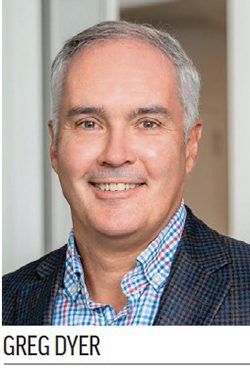
Dyer uses the analogy of cars merging onto an interstate to describe the challenge: “If there were 10 entrance ramps—some of them are curved, some of them go left and some go right, some are fast and some are slow—it would be really complicated. That’s kind of what was happening at Sun Valley. People were just coming from all points of the compass.”
To remedy the situation, radar controllers at Salt Lake Center worked with SUN to narrow the route structure to four or five mini-routes. “What that does is make it like one entrance ramp coming onto the interstate,” Dyer explains. “Now, the pilots and the controllers know where the traffic flow is and where they’re merging. It becomes natural to fall in line and stay in line as you get set up for the runway.”
Salt Lake Center implements this special routing structure on the first day of the event to limit the parameters of the flight plans filed for incoming aircraft. As a result, personnel at the Center can visualize the flow of aircraft very early in the day. Controllers are able to assess the situation 400 or 500+ miles away from SUN and work with other FAA traffic control centers to start putting aircraft in queue to help maintain appropriate spacing.

“They’re able to be more efficient with the sequencing, which really helps with predictability and managing the use of the runway, as it relates to the number of aircraft that can land or take off during a certain amount of time,” Pomeroy says.
He credits Dyer with helping mastermind a new way to manage traffic during the busy annual event. “Greg was able to speak the air traffic language and get us in contact with Salt Lake Center,” Pomeroy explains. “Talking to the Center and getting their thoughts and ideas on what could be done a little bit differently with these new techniques, and thinking through how we implement those, was really one of the most successful components of the new planning effort.”
Salt Lake Center’s recent implementation of ADS-B has been a huge benefit. “Because of our mountainous environment, prior to ADS-B, radar coverage was really not dependable, especially the closer you got to the ground here with the radar signals blocked by the terrain,” Pomeroy explains. “Strategic placement of a couple ADS-B radios in southern Idaho has helped open up the airspace for air traffic control purposes, allowing them to employ more creative techniques, especially when it comes to reduced separation, while still under positive control in the airspace as aircraft get closer to the airport.”
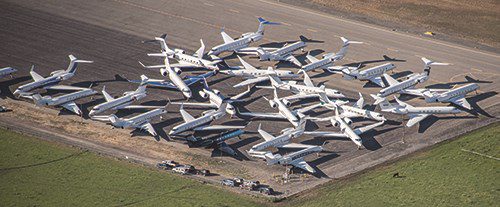
Despite the added technology and best-laid plans, sometimes traffic associated with the Sun Valley Conference is simply too heavy. Last year, volume spiked so quickly that FAA had to issue a short ground stop.
Internal Assets
Although Pomeroy relies heavily on the expertise at the Salt Lake Air Route Traffic Control Center, he emphasizes that the complex traffic orchestration needed every July wouldn’t be possible without the staff in SUN’s air traffic control tower. “They’re the ones who ultimately take over control of those aircraft within our Class D airspace and work to get all the aircraft safely on the ground,” he remarks. “That takes a lot of coordination between the tower and Center, and they do a fantastic job.”
Local controllers are especially critical during departures, a component of SUN’s overall flow that has changed over the past few years due to a significant increase in traffic from fractional operators. “Those aircraft typically don’t sit on the ground. They keep running,” Pomeroy explains. “So we see a lot of ‘drop and go’s’, which really adds to the complexity of operations, especially as it relates to departures. The air traffic controllers at Salt Lake Center and our tower staff have to work together to build in departure windows and bubbles.”
Naturally, Atlantic Aviation FBO is a key player in the planning and execution of the annual event. “We work really well with them, and they’re a major partner at the table as we’re working through the planning,” says Pomeroy. The Atlantic Aviation crew is in constant contact on the busy arrival and departure days to help coordinate aircraft parking on the ramp and facilitate landing and takeoff plans.
With the special route structure in place, Pomeroy and Dyer emphasize that coordination is essential.

“Chris has done a great job with communication,” Dyer says. “I think it’s about being as transparent as possible. You want to be sure everyone knows as much about what’s happening as possible to be able to make the right decisions. You don’t have to micromanage; you just have to share information.”
In addition to initiating ongoing conversations with Salt Lake Center, Pomeroy sends flight crews a letter that details about the routing structure and SUN’s noise abatement program. It’s not difficult to contact the right people because the event’s invite list is carefully curated, and many of the same guests and flight crews return year after year. “Having the ability to distribute that letter with specific information and requests has proven to be very valuable,” he says. “In fact, we hear from a lot of the flight crews in the weeks leading up to the event asking if we’ve sent our letters out yet.”
Dyer reports that SUN gets little resistance about the strict rules regarding airspace usage during the special event. “The world of aviation is made up of good citizens,” he reasons. “If you tell people what the plan is, they’ll do the best they can to work with that plan. You have to just communicate with everybody why it is the way it is.”
Assessing Arrivals
On the first day of the event, Pomeroy and Dyer get up early to start checking the air traffic control Command Center website and checking the weather. They also look at FlightAware maps to get an informal view of the airspace.
“We just kind of get used to the environment and try to figure out what’s going to potentially give us trouble,” Dyer says. Meanwhile, controllers at Salt Lake Center are establishing a scheduling program and determining when various aircraft can leave from their departure points to make overall traffic flow efficient. “They’ll make assumptions about how many aircraft the airport can take an hour, and we’ll share information on that to make sure we’re all on the same page,“ Dyer adds.
Once at the airport, he and Pomeroy check in with SUN’s control tower, continue to monitor FlightAware and publications from the Command Center, and check in with Atlantic Aviation to see what reservations it has.
Throughout the day, the duo stays in constant contact so each knows what the other is observing. “We’re looking at how ramp space is progressing. We’re listening to air traffic control on frequency,” explains Pomeroy. “And when we’re noticing a backlog of departures that need to get out, we are picking up the phone and calling Salt Lake Center to say that we might need to look at a departure bubble in the next 45 minutes or so.’”
In the heat of the arrivals traffic, Pomeroy and Dyer are on the ground in their “mobile command center”—Pomeroy’s truck—cueing the intricate choreography of arrivals and departures with air traffic control via telephone. They closely monitor the ramp and taxiways to maintain safety and keep in constant communication with Atlantic Aviation, SUN’s control tower and the Salt Lake Center to enhance situational awareness for everyone.
“That runway is the most precious timeshare in a large area,” Dyer quips. “You want to keep it as busy as you possibly can. So, if we see that there’s room, we’ll call the Center to see if there’s an aircraft that could fit the gap.”
Toward the end of the main arrivals day, SUN runs out of ramp space to park aircraft. Instead of closing to traffic, it issues NOTAMs that let pilots know the airport is available only for drop-and-go flights. Pomeroy and Dyer work closely with ramp managers at Atlantic Aviation to monitor capacity throughout the day, and stay in close contact with Salt Lake Center to see how many aircraft are still headed their way. That allows controllers to let crews of incoming aircraft know they need to be prepared to either drop and go or divert to the airport in Twin Falls or Boise.
After most of the conference guests have arrived, Pomeroy and Dyer get to relax a bit.
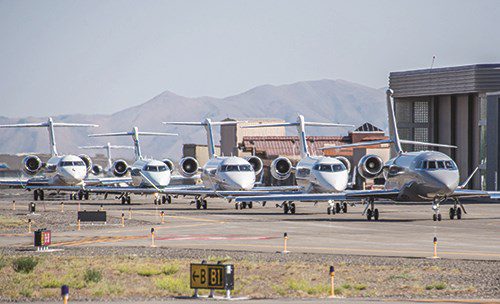
Typically, they head to the pilots’ dinner to rub elbows and talk shop with the flight crews they helped land. Some crews have been coming to the “summer fly-in” at SUN for many years, and most speak highly of the improved route structure. “These are pilots who fly all over the world all the time. They are really educated consumers of airspace, so getting that positive feedback is fun,” Dyer admits.
Pomeroy notes that the routing structure developed for the annual Sun Valley Conference has worked so well, SUN uses it during the airport’s peak winter/skiing season as well.
Departure Day
To manage the busy flow of aircraft taking off on Sunday after the conference ends, airport personnel work with the event organizer to understand when sessions and keynote speakers are wrapping up. This helps them estimate when guests will be coming to SUN, boarding their aircraft and wanting to leave.
Armed with that information, Pomeroy and Dyer devise a plan that includes temporarily closing the airport for arrivals to create more departure windows. “That has been huge, especially when we get the timing just right,” says Pomeroy. “It’s amazing the number of aircraft that depart out of here in that closure-to-arrival period. It’s a very constant stream. It’s been a really effective and really efficient strategy for us.”
“If you hit your timing right, it goes so fast,” Dyer adds. “It’s just beautiful to watch all of those aircraft take off in the blue sky.”
That’s when the high fives begin on the ramp, and Pomeroy reflects about how far the process has come since his first day on the job seven years ago. “While it’s a stressful week, it is a very unique event—the type of people who come, the sheer volume of heavy iron and how much some of those aircraft cost,” he remarks. “Seeing that all come together at our airport…I just love being a part of it. And seeing things improve year after year is very satisfying.”

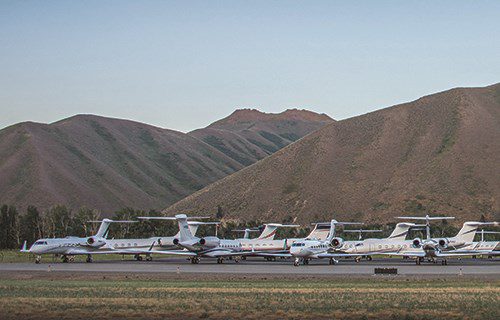
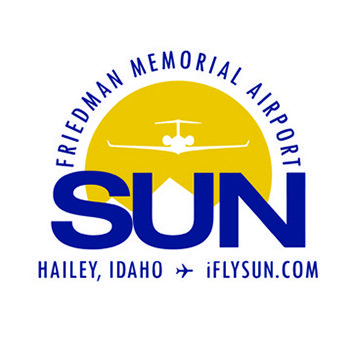 facts&figures
facts&figures

